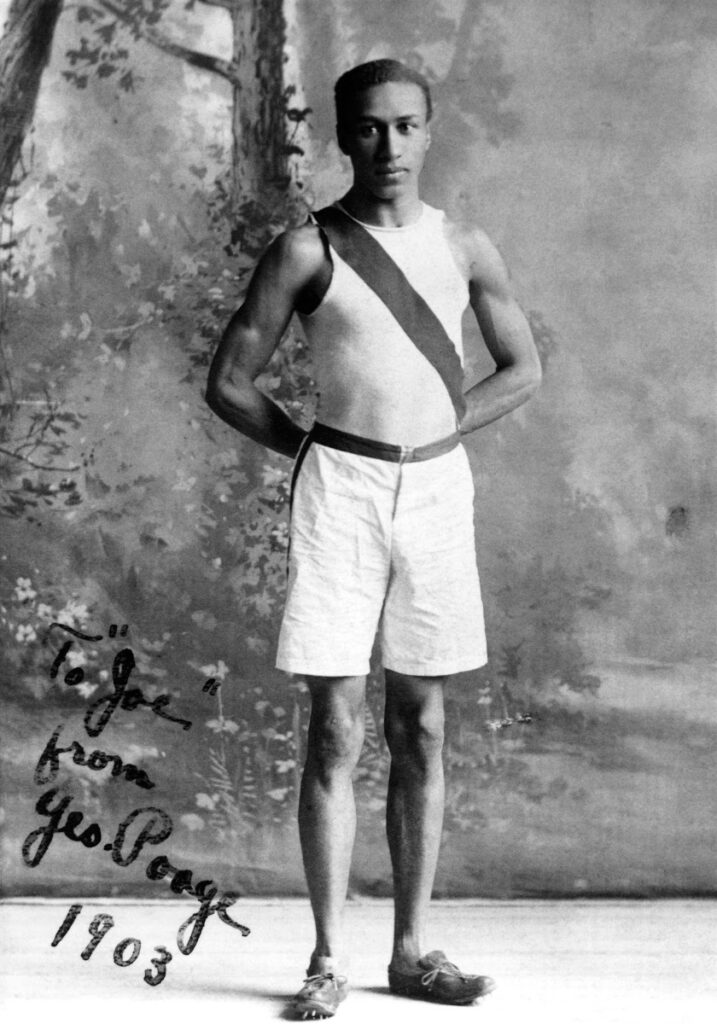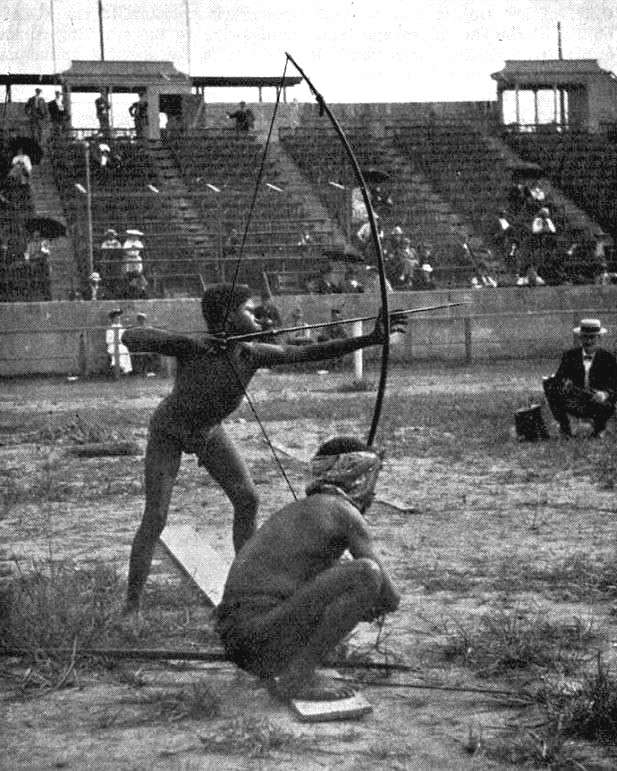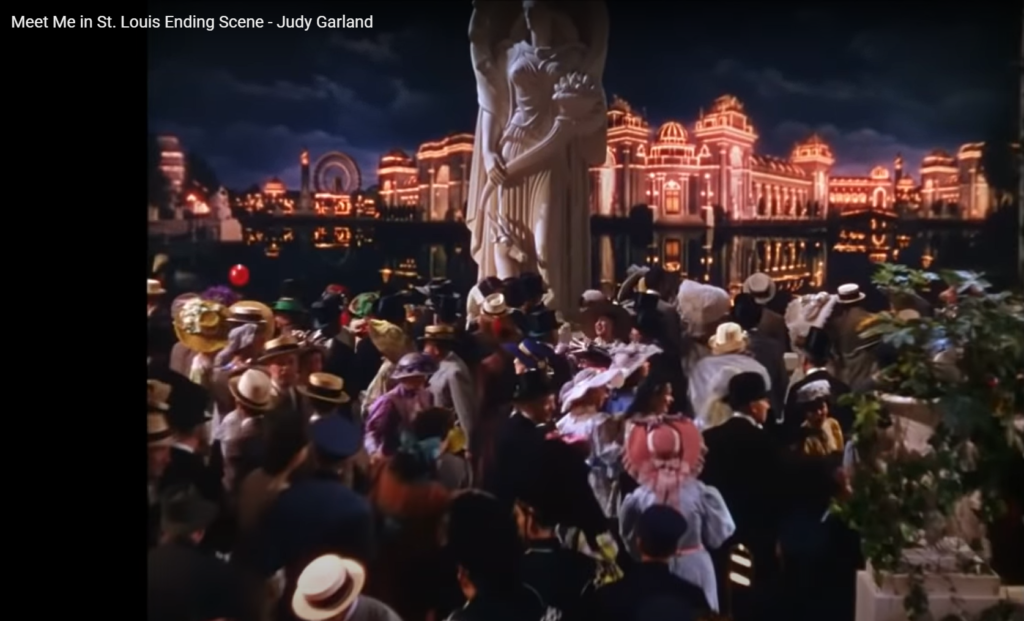I’ve recently talked with a few people who had no idea that St. Louis had once hosted the Olympics and I think it’s something of a shame. You see, I’ve had more head shaking moments reading about the III Olympiad in 1904 than I’ve had in any other research of recent memory. I hope you’ll be surprised and entertained.
Stop thief!
I neglected to mention in the previous post that the 1904 Olympics were held in conjunction with a World’s Fair that was technically called the Louisiana Purchase Exposition. (In an attempt to preempt any other country from claims in the American west, in 1803, President Thomas Jefferson purchased 828,000 square miles [2,140,000 square kilometers] of territory from France for the sum of $15,000,000. Of course, this ignored any claims that might be asserted by the indigenous people already living on this land.) The year 1904 also marked the centennial of the departure of the Lewis and Clark expedition.
(Wikimedia Commons – Public domain)
Knowing that the Olympic founders wanted to show their appreciation for American participation in the two prior games, the planners of the 1904 Exposition made a bid to host the games in conjunction with the World’s Fair. However, Pierre de Coubertin, the founder of the modern games, had already awarded them to Chicago – a city he’d come to admire following his visit to that city’s World’s Fair in 1893. Further, de Coubertin had also been to St. Louis and viewed it as something of a backwater. So how did St. Louis manage to persuade de Coubertin to change his mind and move the Olympics from its rival to the north?
As Woodward and Bernstein learned from Mark Felt in 1972, follow the money. Using the considerable financial resources available to them, the Expo’s organizing committee forged a deal with the Amateur Athletic Union to hold its 1904 track and field championships as part of the World’s Fair. It would be crude to call it a form of blackmail but this created a dilemma for de Coubertin. He had to reconsider because he didn’t want to face a competing athletic event particularly since it meant that American athletes associated with the AAU would only be able to compete in St. Louis. Coubertin neglected to attend the games and later wrote, “I had a sort of presentiment that the Olympiad would match the mediocrity of the town.”
The mediocre, the embarrassing, and the bizarre
While not invented at the St. Louis World’s Fair or Olympics, the ice cream cone, iced tea, hamburger, and hot dog were widely promoted there and gained in popularity as a result.
A number of non-Olympic athletic events took place during the two somewhat conjoined events. These included an Irish sports festival and a YMCA basketball championship. Following an official review to identify the 94 events that should be rightly included as sanctioned Olympics competition, the entirety of the Games were determined to have occurred over 146 days from 1 July to 23 November with most of the track and field events held between 28 August and 3 September.
It was the first that would hand out gold, silver, and bronze medals.
(From St. Louis Today)
The United States won 231 of the 280 medals awarded. America’s 77 gold medals alone was more than the number of total medals won by all other countries. However, we need to keep in mind that St. Louis was both costly and difficult to reach in 1904 so only a piddling 11 nations joined the U.S. in competing at the games. Of the 630 competing athletes, 523 were Americans or were claimed as Americans by the U.S.A. The American team actually included several European immigrants who weren’t yet citizens. In fact as recently as 2012, Norway was still asking the International Olympic Committee to officially change the nationality of two gold medal-winning wrestlers.
Tug of War was one of the Track and Field events. (It was an Olympic mainstay from 1900 until 1920.)
St. Louis constructed a new golf course, Glen Echo, to host the Olympic competition in that sport. Because of a dispute about the format, the golf tournament scheduled for 1908 in London was canceled. Golf wouldn’t reappear as an Olympic event until the Rio de Janeiro Games in 2016.
Of the 94 officially sanctioned events, women were allowed to compete only in archery. The competition took place on 19 and 20 September and involved six contestants, five of whom were part of Ohio’s Cincinnati Archers Club. Lida Howell, age 45, and the nation’s undisputed top female archer, easily won gold medals in both the Double Columbia and Double National rounds.
Curiously, women also stepped into the ring as Olympic boxers. However, their bouts were considered display events and no medals were awarded. It required the passage of 108 years before women were again permitted in the Olympic boxing ring but women’s boxing was a medal competition in London in 2012.
George Coleman Poage
(Murphy Library / University of Wisconsin-La Crosse – The Olympic Museum)
was the first African-American athlete to win a medal in the Olympic Games, winning bronze medals in the 200 and 400 meter hurdles.
And now for the embarrassing. August 12 and 13 brought to the Olympics something the promoters called
“Anthropolgy Days”.
In 1880, a man named James Edward Sullivan founded a paper called The Athletics News. About eight years later on 21 January 1888, he helped establish the Amateur Athletic Union (AAU) and in 1904, he played an oversize role in not only bringing the Olympics to St. Louis but overseeing the competitions at both the Games and the World’s Fair. Sullivan wanted to demonstrate and extol the superiority of American style athletics, American athletes, and the white race.
For a bit of context, I need to provide a peek at some of the exhibits of the Louisiana Purchase Exposition. In addition to the expected industrial exhibits, visitors to the 1904 Fair could see the world’s largest organ and Abe Lincoln’s boyhood cabin. The could sample new gustatory treats like cotton candy or those mentioned above. And, of course, spread over 47 acres (19 hectares), they could visit what was effectively a human zoo.
Visitors could gawk at a Philippine village, featuring both people and animals from America’s newly acquired Pacific territory in a replicated “native habitat.” And if that weren’t enough, the organizers constructed smaller “villages” to house Pygmies from Central Africa, American Indians from Mexico, Syrians, Turks, and other “savages.”
Sullivan joined with William McGee, the Fair’s Director of Anthropology, to hold what they called called a “Special Olympics” where these “inferior savages” would attempt to mimic their white counterparts. Despite providing neither training nor instruction to his subjects and in spite of their indifference and reluctance to participate, their failures would demonstrate their inherent inferiority.
The first day featured European-style competitions such as the shot put, high jump, long jump, the mile, and 100 meter sprint. The second day was more “savage friendly” in the organizers eyes. The events included a tree-climbing contest, archery, fighting demonstrations, a Mohawk vs. Seneca lacrosse match, and mud throwing.
(From AmusingPlanet.com)
The event was hastily organized, poorly promoted, and, as you can see from the above photo, sparsely attended. Still, for Sullivan and McGee, the failures of the “savages” made the event a success. Hearing reports of the events, de Coubertin managed to be simultaneously horrified and supportive saying that the Olympic Games, “will of course lose its appeal when black men, red men, and yellow men learn to run, jump and throw, and leave the white men behind them.”
One additional event worthy of discussion from the 1904 Games remains – the marathon. It’s bizarre enough to merit its own post. For now, I’ll leave you with this image:





A lot to unpack with this one, starting with the Louisiana Purchase, one of the most underrated events that built this country in our history.
My favorite line:
“Hearing reports of the events, de Coubertin managed to be simultaneously horrified and supportive saying that the Olympic Games, “will of course lose its appeal when black men, red men, and yellow men learn to run, jump and throw, and leave the white men behind them.”
Bigoted, ignorant and prescient at the same time.
All at the same time, indeed.